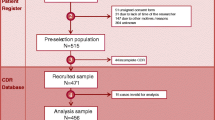Abstract
Rotavirus gastroenteritis is the leading cause of severe acute gastroenteritis in children worldwide and is associated with high hospitalization and mortality rates in children younger than 5 years of age. Vaccination is necessary to prevent rotavirus infection. Two live attenuated and orally administered rotavirus vaccines became commercially available in Korea. The aim of this study is to describe epidemiological changes in rotavirus gastroenteritis after the introduction of rotavirus vaccines in Korea. The medical records of 11,199 children younger than 5 years of age and hospitalized for acute gastroenteritis from August 2007 to July 2010 in eight Korean hospitals were reviewed. Rotavirus was detected in stool samples obtained from 2,959 children (26.42 %). The authors evaluated the percentage of rotavirus gastroenteritis among all acute gastroenteritis hospitalizations in eight hospitals located in different geographical areas and analyzed epidemiological changes in rotavirus gastroenteritis according to age, geographical area, and season. According to the findings, the percentage of rotavirus gastroenteritis showed a decrease in children eligible for vaccination during the study period. After introduction of the vaccine, reduced rates of rotavirus detection were observed in all of the geographical areas, and the greatest reduction was observed in Seoul. In Seoul, there was a marked delay of the rotavirus season. Conclusion: Epidemiologic changes in Korea after the introduction of rotavirus vaccine are consistent with changes observed in other countries.


Similar content being viewed by others
References
Atchison CJ, Tam CC, Hajat S, van Pelt W, Cowden JM, Lopman BA (2010) Temperature-dependent transmission of rotavirus in Great Britain and the Netherlands. Proc Biol Sci 277:933–942
Bass DM (2011) Rotavirus, caliciviruses, and astroviruses. In: Kliegman RM, Nelson WE (eds) Nelson textbook of pediatrics, 19th edn. Elsevier Saunders, Philadelphia, pp 1134–1137
Butz AM, Fosarelli P, Dick J, Cusack T, Yolken R (1993) Prevalence of rotavirus on high-risk fomites in day-care facilities. Pediatrics 92:202–205
Centers for Disease Control and Prevention (2008) Delayed onset and diminished magnitude of rotavirus activity – United States, November 2007–May 2008. MMWR Morb Mortal Wkly Rep 57:697–700
Chae JH, Kim MJ, Kim DH, Lee KY, Kang JH, Lee JS (2007) Epidemiologic study of rotaviral gastroenteritis in Daejeon, Korea, 2001–2005. Korean J Pediatr Infect Dis 14:155–161
Chang HG, Smith PF, Tserenpuntsag B, Markey K, Parashar U, Morse DL (2010) Reduction in hospitalizations for diarrhea and rotavirus infections in New York state following introduction of rotavirus vaccine. Vaccine 28:754–758
Charles MD, Holman RC, Curns AT, Parashar UD, Glass RI, Bresee JS (2006) Hospitalizations associated with rotavirus gastroenteritis in the United States, 1993–2002. Pediatr Infect Dis J 25:489–493
Committee PRE (2006) The paediatric burden of rotavirus disease in Europe. Epidemiol Infect 134:908–916
Fischer TK, Bresee JS, Glass RI (2004) Rotavirus vaccines and the prevention of hospital-acquired diarrhea in children. Vaccine 22(Suppl 1):S49–S54
Kang JH (2008) Clinical epidemiologic profile of rotavirus infections in Korea. Korean Pediatr Infect Dis 15:5–11
Kang JO, Kim MN, Kim JU, Suh HS, Yoon YM, Jang SJ et al (2002) Epidemiologic trends of rotavirus infection in the Republic of Korea, July 1999 through June 2002. Ann Lab Med 23:382–387
Kim JS, Kang JO, Cho SC, Jang YT, Min SA, Park TH et al (2005) Epidemiologic profile of rotavirus infection in the Republic of Korea: results from prospective surveillance in the Jeongeub district, 1 July 2002 through 30 June 2004. J Infect Dis 192(Suppl 1):S49–S56
Lanzieri TM, Costa I, Shafi FA, Cunha MH, Ortega-Barria E, Linhares AC et al (2010) Trends in hospitalizations from all-cause gastroenteritis in children younger than 5 years of age in Brazil before and after human rotavirus vaccine introduction, 1998–2007. Pediatr Infect Dis J 29:673–675
Moe K, Shirley JA (1982) The effects of relative humidity and temperature on the survival of human rotavirus in faeces. Arch Virol 72:179–186
Orenstein EW, Fang ZY, Xu J, Liu C, Shen K, Qian Y et al (2007) The epidemiology and burden of rotavirus in China: a review of the literature from 1983 to 2005. Vaccine 25:406–413
Parashar UD, Hummelman EG, Bresee JS, Miller MA, Glass RI (2003) Global illness and deaths caused by rotavirus disease in children. Emerg Infect Dis 9:565–572
Parez N (2008) Rotavirus gastroenteritis: why to back up to development of new vaccines? Comp Immunol Microbiol Infect Dis 31:253–269
Payne DC, Staat MA, Edwards KM, Szilagyi PG, Weinberg GA, Hall CB et al (2011) Direct and indirect effects of rotavirus vaccination upon childhood hospitalizations in 3 US Counties, 2006–2009. Clin Infect Dis 53:245–253
Richardson V, Parashar U, Patel M (2011) Childhood diarrhea deaths after rotavirus vaccination in Mexico. N Engl J Med 365:772–773
Seo JK, Sim JG (2000) Overview of rotavirus infections in Korea. Pediatr Int 42:406–410
Suzuki H, Sakai T, Tanabe N, Okabe N (2005) Peak rotavirus activity shifted from winter to early spring in Japan. Pediatr Infect Dis J 24:257–260
Uhlig U, Kostev K, Schuster V, Uhlig HH (2011) Rotavirus vaccination in Germany: analysis of nationwide surveillance data 2006 to 2010. Pediatr Infect Dis J 30:e244–e247
Yang BM, Jo DS, Kim YH, Hong JM, Kim JS (2008) The societal cost of rotavirus infection in South Korea. Korean J Pediatr 51:977–986
Conflict of interest
The authors declare the following financial interest: All authors received research grants for this study from MSD Korea Ltd.; however, this had no influence on conduct of the study, interpretation of results, and writing of this article. All authors state that they have no conflict of interest.
Author information
Authors and Affiliations
Corresponding author
Rights and permissions
About this article
Cite this article
Choi, U.Y., Lee, S.Y., Ma, S.H. et al. Epidemiological changes in rotavirus gastroenteritis in children under 5 years of age after the introduction of rotavirus vaccines in Korea. Eur J Pediatr 172, 947–952 (2013). https://doi.org/10.1007/s00431-013-1974-y
Received:
Revised:
Accepted:
Published:
Issue Date:
DOI: https://doi.org/10.1007/s00431-013-1974-y




